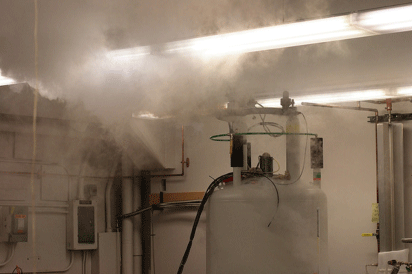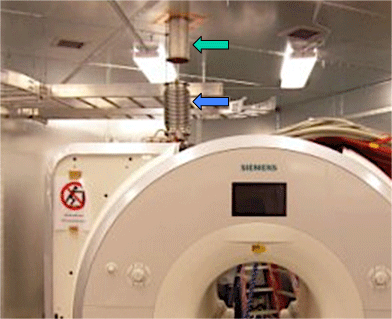|
A quench refers to the sudden loss of superconductivity when its temperature is raised. In the superconducting state, the resistance of the magnet coil windings is zero and hence no energy is required to maintain current flow. If the coil temperature rises above the superconductivity threshold (Tc), the windings suddenly develop a finite resistance. The several-dozen amperes of circulating current passing through this elevated coil resistance create heat. This heat causes a sudden, explosive boil-off of liquid helium.
|
In my 30 years of clinical experience with MRI at one institution, I have observed several unexpected magnet quenches as well as a few planned quenches in conjunction with decommissioning older magnets. All occurred during installation or servicing when no patients were present. There were no injuries and most of the boiled off gases were vented safely outside the building. Here is my personal account of one such quench:
The only warning of the impending quench was 5-10 seconds of a mild hissing sound caused by a small volume of helium escaping through the boil-off valve. Roaring or loud hissing then followed for about 20-30 seconds as great quantities of gaseous helium were released. As our facility was properly designed, nearly all of the released cryogens escaped through a vent tube to the rooftop, where a large cloud of vapors could be seen billowing into the sky. Although most of the gas was vented outside, some cryogens also escaped into the scanner room as well, filling it with a smoke-like mist. The cold vapors produced a marked chill in the air, with a sudden drop in room temperature by at least 10-15 degrees.
Although gaseous helium is lighter than air and will float to the top of the room, large quantities can completely displace oxygen from the entire room and if inhaled may cause loss of consciousness within 10 seconds with the possibility of asphyxia and death. Patients and staff must therefore be evacuated immediately from the scanner room if a quench occurs.
The only warning of the impending quench was 5-10 seconds of a mild hissing sound caused by a small volume of helium escaping through the boil-off valve. Roaring or loud hissing then followed for about 20-30 seconds as great quantities of gaseous helium were released. As our facility was properly designed, nearly all of the released cryogens escaped through a vent tube to the rooftop, where a large cloud of vapors could be seen billowing into the sky. Although most of the gas was vented outside, some cryogens also escaped into the scanner room as well, filling it with a smoke-like mist. The cold vapors produced a marked chill in the air, with a sudden drop in room temperature by at least 10-15 degrees.
Although gaseous helium is lighter than air and will float to the top of the room, large quantities can completely displace oxygen from the entire room and if inhaled may cause loss of consciousness within 10 seconds with the possibility of asphyxia and death. Patients and staff must therefore be evacuated immediately from the scanner room if a quench occurs.
To my knowledge a quench-related death or serious injury has never been reported in a clinical MRI facility. Theoretically, the most dangerous situation would be if the quench tube became blocked or disconnected, allowing lethal quantities of helium to escape into the scanner room. This could increase pressure in the room making the door hard to open. In addition to asphyxiation, high concentrations of gaseous helium in this setting could cause thermal injury to eyes or skin.
If electrical power is lost or the cryogen pump system goes down, MR magnets are sufficiently well insulated that they can go several days to a week without becoming warm enough to quench. This allows magnets to be pre-filled with liquid helium at the factory and "cold-shipped" to the receiving facility, thus reducing installation time.
Fortunately, with the new generation of sealed, low-volume helium scanners, sudden loss of superconductivity does not produce release of gas, and a quench tube for venting is not required.
References
Care with Cryogenics. A safety guide to handling cryogenics provided by BOC, the UK's largest supplier of industrial gases (http://www.boconline.co.uk).
Care with Cryogenics. A safety guide to handling cryogenics provided by BOC, the UK's largest supplier of industrial gases (http://www.boconline.co.uk).
Related Questions
Don't superconducting scanners consume liquid helium? How often does it need to be replenished?
Don't superconducting scanners consume liquid helium? How often does it need to be replenished?


